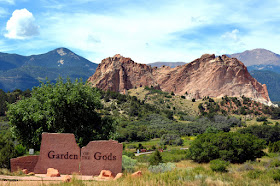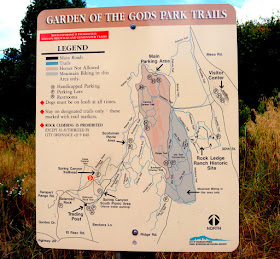Wouldn't you like to hike up a winding trail through beautiful aspens groves to see a majestic 283-foot waterfall in a wilderness area of Colorado? A place like this, that is very accessible for all to see, is Fish Creek Falls just five miles east of Steamboat Springs, in the Routt National Forest. (All photos, and photo collages, in this post, will enlarge for easier viewing if clicked on)
There are several hiking trails from the parking lot at the end of Fish Creek Falls Road ($5 a day parking fee, at this writing, for an all-day vehicle pass). One trail is an easy 1/4 mile (400m) and ends at a viewing station where the entirety of the falls can be seen. Another trail goes straight down into the U shaped valley that was formed by glaciers during the Ice Age.
Click on to enlarge to see the trail map.
Along the scenic overlook trail, there were many interesting placards to read.
Click on the photo collage above to enlarge it to see the info on the other placards. They give information about the importance of water to the ecological balance of Colorado and its wildlife and trees. Snowmelt makes up the bulk of water in our state, and that water also feeds into many other states' water supplies. The average US household uses over 600 gallons of water a day! Conserving water is important everywhere, as our population grows worldwide. Fish Creek drainage is one of the highest producers of water in the state of Colorado.
Our first view of the Fish Creek Falls! We visited in early October, so the stream of water going over was not as great as it would have been with the spring snowmelt time, as the Steamboat area receives over 300 inches of snow throughout the winter. It also increases flow after a summer afternoon thunderstorm.
Even though they were not at peak flow, the falls were still impressive!
He sat by the falls for some time and I was very relieved when he climbed back on top to safety. I would not recommend anyone doing this. I'm sure it is not allowed and that it can be very dangerous!
If you'd like to listen to the sound the upper Fish Creek Falls made please click on this direct link to a short video I made on my Mille Fiori Favoriti Facebook page.
A close up at the bottom half of Fish Creek Falls...
.... and the lowest section roaring over the large boulders on the bottom.
People were also exploring the bottom of the falls. I don't think the water is very deep, but I'm sure those boulders could be slippery!
My husband and I did a loop trail that leads to the bottom of the falls and along the way, we saw a placard that described the history of the falls and their importance to Steamboat and many other watersheds. Please click on the collage to read this info.
My husband and I looked at the falls in this area, from a historic bridge that crosses over the creek. It was first built in 1927 and replaced in 1988. If you'd like to listen to the sound of the roaring waterfalls at this point click on this direct link to that video on my Mille Fiori Favoriti Facebook link
The trails along Fish Creek reflect the Riparian zone and are full of lush foliage--ferns, shrubs, berries, scrub oak, pine and aspen trees.
Even though peak autumn color was past prime at the time of our visit, we still saw some beautiful colors and I had fun photographing much of it.......
...as you can see by this photo mosaic!
It was almost the end of autumn in NW Colorado, and soon the snow would be falling, making the Steamboat Springs ski areas come alive!
It was almost the end of autumn in NW Colorado, and soon the snow would be falling, making the Steamboat Springs ski areas come alive!
Back home in our area, SW of Denver, we've already had snow a few times! It doesn't last on the ground very long in our altitude of 6,000 feet. The sun comes out and most of the snow melts quickly, as the day time temperature goes into the 50's and 60's We've also been walking a new trail that was made by our community's trail club near our home. It leads up towards the foothills and gives us a good workout!
This is Thanksgiving week in the US, and I know many of my readers will be busy cooking, traveling and celebrating. Enjoy and be safe! This year, we gather together with our families and friends to give thanks for all our blessings, let us also say a prayer for peace for this turbulent world!
Have a very Happy Thanksgiving!!
























































